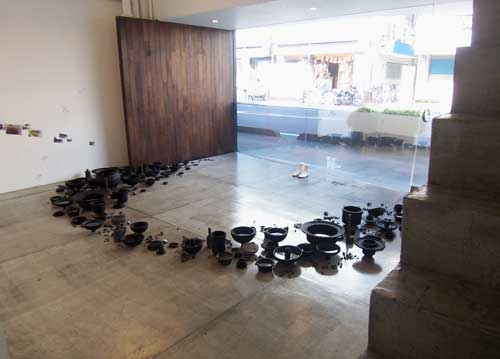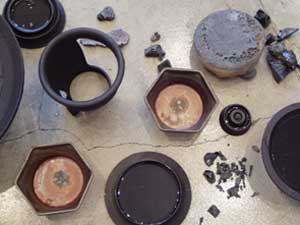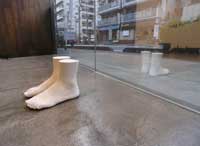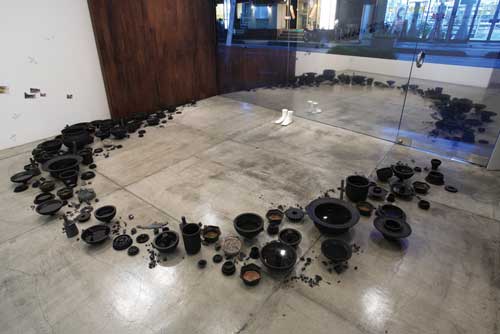|
|
|
Cycle - Flow of Time through the Fluid Mirror 0610 2006
|
|
|
|
 |
|
|
|
photo: MOTOYAMA |
|
|
|
metal castings, half-mirrored sheet, plaster,
water, oil, photo images, etc.
H.150cm, W.520cm, D.450 cm
masuii R.D.R / Kawaguchi, Saitama
[Between ECO & EGO 2006] |
|
|
|
In the foundry process, old scrap metals are melted and made into new products. I have transformed this entire operation into a symbolic representation of a variety of time and life cycles involving humans, for example, the continuation of species through death and reproduction, the dynamics of ever-changing cities and the revolution of planets in their orbit. In front of a half-mirrored glass wall, a wide range of metal castings arranged in a half circle creates a full circle reflected in the mirror. This circle image also blends with the outside through the half-transparent glass, integrating the views from both inside and outside. The water or oil in the metal containers reflects what it sees and tells of the passage of time through the rusting of the metal parts. I imagine that this circle is made up of such "microcosm" containers holding everything including species, environment and time, and slowly rotates while seeing people and cars come and go, while stores blaze brightly with neon lights, the sky shows its colors and the rain ripples on water. |
|
|
|
 |
 |
|
|
|
 |
|
|
 |
|
 |
|
|
photo: OHTANI Kenji |
|
|
|
An Autumn Day, 2006
HIRAI Ryoichi (Art Critic)
Behind the feet stood a glass wall, onto the lower part of which Maruyama had attached half-mirrored sheets which symmetrically reflected the room. The glass was intended to produce the visual effect of the inside and outside of the room combined into a single space, with the feet including those reflected in the fluid mirror seeming to represent people coming and going. This correspondence indicated that this place was connected to not only that visual effect but also the message Maruyama aimed to convey. Meanwhile, the plaster mold itself seemed to have double meanings: it clearly stood for human feet without doubt but distorting the real meaning at the same time. Even the spectrum of the lustrous white plaster subtly inflected the view of the installation. Maruyama must have caught a glimpse of the critical point where materials were changed into images in her past installation "How can we understand others? (2006)" by carefully arranging the scattering of broken pieces of plaster molds and a two pairs of molded human feet. In any artistic execution in response to harsh reality, the artist could merely respond by using materials and places as media. However, Maruyama's environmental concept of coexistence with others was represented in the fluid mirror, which silently told of the passage of time. This beauty of her exhibition was really worthy of admiration.
(Extract from the essay in the document book [Between ECO & EGO 2006])
|
|
|
|
 |
|
|
 |
|
|
|
 |
|
|
|
|
|
|
|
|
|
|
|
|
|
|
|
|
|
|
|